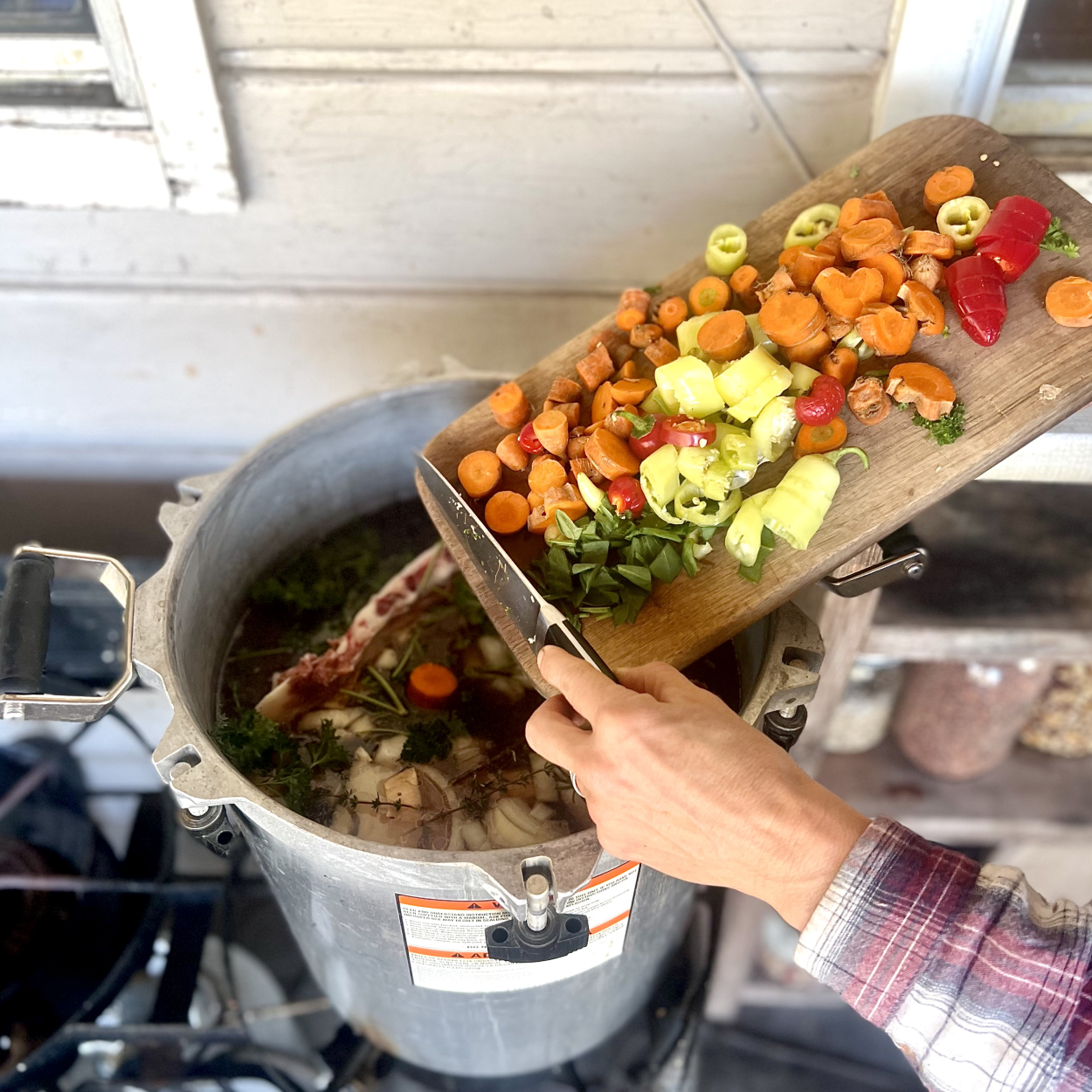Starting February 15, 2022, we will no longer purchase or eat any food from the grocery store (except salt & baking powder). Instead, we are choosing to experience what it is like to raise and forage for all of our food. This means EVERYTHING: flour, oil, honey, spices, cheese, fruits, nuts - Follow our journey and learn about feeding yourselves

If you have ever processed an animal at home, you don't want this animal to have died in vain, and so like me you may be interested in making use of as much of the animal as possible. After processing the animal to make use of the meat, one is left with lots of bones. Naturally this leads to the increasingly common query: how to make bone broth.
It is surprisingly simple to make bone broth at home, provided you have one key piece of equipment: a pot large enough to contain all of the liquid and other ingredients.
If you decide to can the broth (as opposed to freezing it), you will also need a pressure canner. One with a simple weighted gague will suffice, as 10 pounds of pressure is what you're aiming for (at sea level or up to 2000 feet above).
It is not necessary to stick closely to a recipe. Keep in mind that broth is simply a step-up from water in terms of adding flavor to your cooking, and an arguably essential ingredient in some recipes. That said, the potency of the broth is not critical. This means that the ratio of water to bones is not crucial. Nor is it very important that your quantities of herbs and spices match what I have listed. For that matter, you can season the broth with different ingredients altogether. The recipe that follows is what I did today. I also referenced Stocking Up and was shocked to find that my haphazard guess at amounts was pretty much spot-on with what they published. That will never happen again, I assure you.
1 goat, sheep or deer carcass (or that from 2-3 chickens)
12 quarts (3 gallons) water
salt to taste (optional; I used almost 1/2 tsp per quart)
2 onions, coarsely chopped (I throw in skins and everything if homegrown or organic - the stock will be strained, so who cares?!)
6 carrots, coarsely chopped (this is a perfect use for imperfect veggies. I had carrots we harvested 3 months ago and some were getting soft. "Stock pot for you!")
3 bell peppers (here again, I add seeds, stems, the whole kit and kaboodle - I'll be straining, so being less particular saves time now)
1 head garlic, cloves smushed and coarsely chopped (once again, I don't even toss the peels)
1-2 jalapeno peppers, sliced (optional)
1 cup fresh herbs (I used parsley, rosemary, thyme and sheep sorrel, as these were still fresh) - I chop and add stems and all
1 tsp black pepper &/or juniper berries (or white pepper)
2 tsp. dried cutting celery (or 2 Tbsp fresh - or 1 cup chopped celery)
1 Tbsp. apple cider vinegar (the vinegar helps leach calcium and other minerals from the bones into the stock!)
Add everything to the pot and bring to a boil. Reduce heat and simmer for 2-3 hours. A bit of steam will escape. If you don't want to add humidity to your house, and have the means, try cooking outside. Conversely, if it is wood stove season, as it often is when home butchering occurs, then added humidity inside can be a boon. Be aware of the weight of this huge pot, however. My stove is old and not well made.
After simmering, strain, saving just the liquid for your stock, or chopping and adding the bits of meat if you prefer. I've even saved all the solids and canned it for dog food, which my dogs looooooovvvee!
From here, you should skim off the fat, which is liquid and floats. Alternatively, you can cool the skimmed broth and scrape off the congealed solid fat. Then re-heat.
Once skimmed of surplus fat, pour into jars and process. Save 1" headspace. Can at 10 lbs of pressure. For pints, 20 minutes, for quarts 25 minutes will do.
Are many!
Starting February 15, 2022, we will no longer purchase or eat any food from the grocery store (except salt & baking powder). Instead, we are choosing to experience what it is like to raise and forage for all of our food. This means EVERYTHING: flour, oil, honey, spices, cheese, fruits, nuts - Follow our journey and learn about feeding yourselves
RESOURCE
Copyright © 2024 Barefoot Farm
Terms & Condition . Services . Careers
